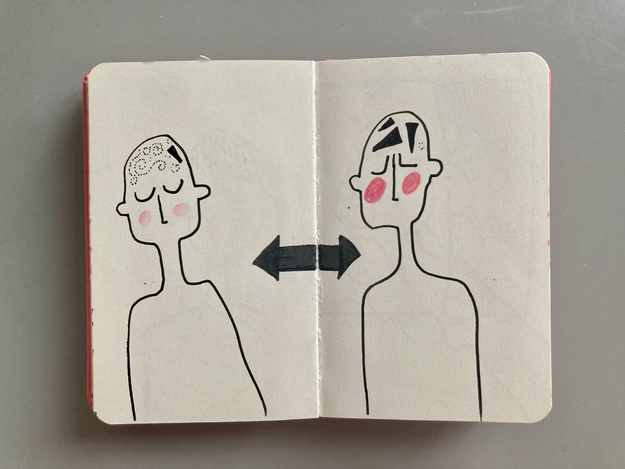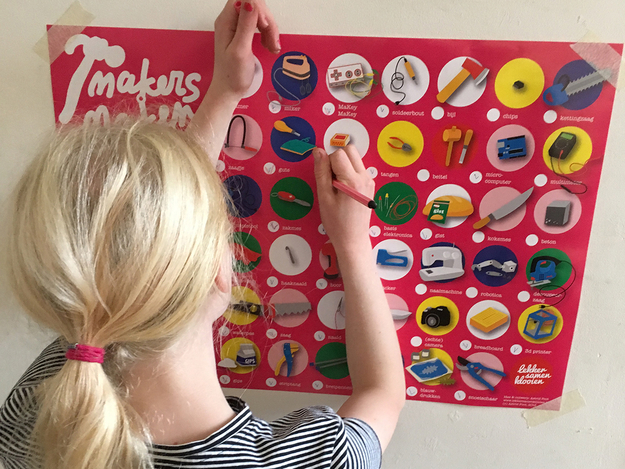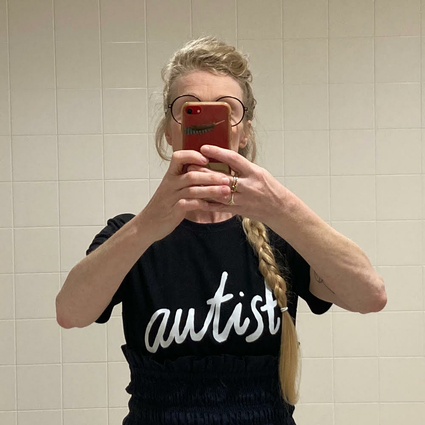Q: Can you tell us a bit about your background? As a designer, founder and author, you have worked on a lot of exciting projects!
A: I started with both Fine Art and graphic design and graduated in the latter. Ever since I was in art school, I’ve wanted to solve problems that I could see around me in a rather – well, you could call it obsessive – way. When I started my career, I immediately jumped onto the internet, because for me it was a very new, democratic, interesting place where I felt there was room for different kinds of people to share things without a traditional hierarchy. My second job was actually at Mediamatic, which I still remember as a very important period in my life!
Q: Could you say something about your career leading up to the GoedMaken project?
A: At first I thought that if I was going to be an influential designer, solving real problems, I had to work in the agency world. I worked at many different agencies and tried to influence the projects that we were realizing there. I always chose to work on projects which I was convinced were good for the world and never challenged my conscience with a project I really didn't want to do, which I'm very proud of. However, eventually, I realized that if I really want to pursue the topics that are most personally important to me, I’d have to take a more independent stance in the field. That’s why I founded my first organization, Lekkersamenklooien (“Making a nice mess together’). It’s about the maker movement, about technology and playfulness and being inventive.
Q: Can you tell us a little bit more about that?
A: I think the core of the maker movement is that it’s a place where many people, and many strange people, fit in, and where you can actually do anything you want as long as it's something you enjoy doing. First we aimed at showing how parents could explore the joy of making things together with their children, but soon after, schools asked us to develop materials for them, too. This went on for many years and I wrote a book about it, held a lot of lectures and helped a lot of schools with the maker education. I could tell that the idea had landed, and a lot of people resonate with the concept of making with a more playful attitude.
Q: How did your work turn from this towards the topic of ethics?
A: I feel the same urgency concerning the topic of ethics. Being a designer myself, I see that many bad products keep being designed even though I've never met an evil designer. I couldn't wrap my head around that. So I decided to explore this question: “How come all these nice people make this awful stuff?“ This became my next project, and I'm in the middle of it now.
The common theme in all my work is always that something in society bothers me and I can't let it go, it becomes obsessive. So I study the issue and it becomes another project. After that I discuss it with many other people and learn from their knowledge because I feel so insecure about the topic I’m researching. In that sense, being insecure about a topic is actually a really nice way to open up a discussion, so I hope to stay that way. Two years ago, I found out that I am autistic, which is funny, because it also explained a lot for me.
Mogen ontwerpers sturen? - Illustration from the GoedMaken project by Astrid Poot
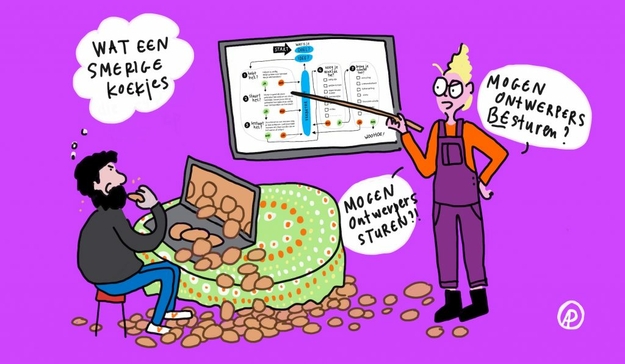
Q: Turning to the topic of how we can design for neurodivergence, we wanted to ask what was your initial drive to speak openly about your autism in recent years?
A: The reason that I “came out“ as autistic was that in the maker movement especially, I met many people who are neurodiverse and who don't fit the norm. It's a very safe and friendly environment, and it's also very creative and powerful. I'm always quite sad when people talk about neurodiversity as something you only suffer from and you need help with. Obviously many people need help with it because society is not very friendly for neurodiverse people. My own father died from a deep depression and struggling with his autism. It also negatively impacts me in other ways, because I tend to overwork and stretch myself too thin.
But the main reason I share my autism is that I also perceive being neurodiverse as a very positive force that really structures my life and helps me focus on the things that matter to me, and it’s a force that I think we could use much better.
Q: Thank you for sharing that with us. And what does your upcoming presentation title ‘All or nothing: healing the world with friendly force’ mean to you?
A: When it comes to designing for neurodiverse people, it's very important to be friendly towards everyone, which is already sort of the standard in the maker movement. Looking at education, with my foundation we encourage play, we encourage different approaches, all you have to do is be a supportive teacher, sometimes being strict, but always being very aware of the person that sits in front of you. There are many improvements we can make in our education and working culture to create less competitive and more attentive and friendly environments which would benefit everyone, not only neurodiverse people. It’s all about safety and allowing differences.
Q: You're also teaching at CMD Amsterdam, and you've developed a lot of educational projects for museums, libraries and cultural organizations. How do you think art education and cultural spaces can meet the needs of people on the spectrum?
A: It's the million dollar question, right? I think again, it is about celebrating diversity. What I found in my ethics research is that many people tend to dismiss their own experiences in favor of theoretical knowledge. For students, I believe it's very important to acknowledge who you are and celebrate how different we are. I opened the academic year asking questions like, how many of you are cat people? How many are neurodivergent? How many are introverts? How many are angry? Then I told them: Now you realize that there's so much knowledge and experience combined in this group, you have to acknowledge it and use it. Because it really helps you grow as a designer to be empathic and have this kind of open perspective on topics.
So that’s my advice to schools and academics to help meet the needs of people on the spectrum: Embracing openness and using this diversity as a rich source of knowledge and inspiration.And what I want to do working with art education and museums is removing the elite attitude around art, the idea that we go into the museum to look at masterpieces and we come out enriched in some way. I usually ask my students and the users of my materials to become artists themselves, to work in the spirit of the artists they are going to look at but also discover a creative side of themselves in the process. In that way, instead of just looking at something and being impressed, you can be part of it and feel enriched as a person and not just as an onlooker.
Is ethiek moeilijk? - Illustration from the GoedMaken project by Astrid Poot
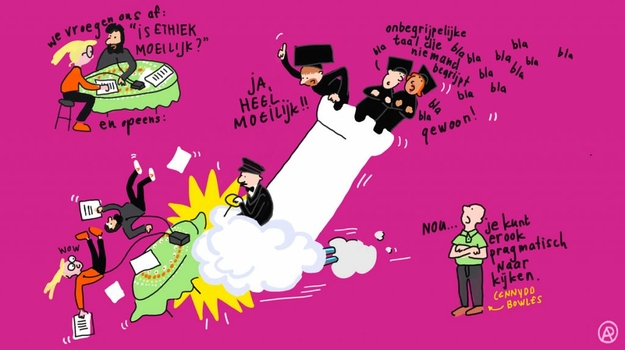
Q: Throughout your research into ethics, what are some powerful insights you might like to share? How might it shed light on the social acceptance of neurodivergence?
A: One of my biggest insights has been the fact that the question: “What is a good designer?“ has no answer. There are many books on ethics in design, very clever books with very normative ideas of how you need to be in order to be a good designer. But I also talked to other designers, and they tell me that they can’t be ethical designers because that would mean passing up work opportunities when they feel lucky to even find a job in the first place. So in the end, everyone has to decide for themselves what a good designer is and how to be a good designer. There is no answer, but we have to keep asking ourselves the questions anyway.
Another insight is that knowing yourself is very important. That means understanding your own background and celebrating the way you were brought up, your religion, your neurodiversity – because you are a unique person, and you have a lot to offer because of that. From this self knowledge comes self-esteem, and self-love as well. And when you have all of that, you can enter into a dialogue with other people, and that’s where the ethics start.
It’s important to challenge the comfort of narrow-minded and uniform spaces that don’t embrace people’s diversity, be it in friend groups, companies, or other areas of life by engaging in an open dialogue with other people.
Q: Could you tell us a bit more about your current project, Goed Maken?
A: Yes! So when I started my ethics project, I thought I would have to write a book, because it's what you’re expected to do at a certain point in your career. But then I thought, not everyone has the time to read big books. I also found out that many people believe that ethics are very difficult, that you have to study Kant for 20 years before you're entitled to say anything about it.
So I decided to make a little experimental DIY ethics book including some very nice little ideas for designers and makers to see how you are defining ethical boundaries without having to force yourself into being too brave right from the start. It's very okay not to be brave.
DIY Ethiek Handboek Gedrukt from Goed Maken - Credit to Astrid Poot , sourced from goedmaken.org 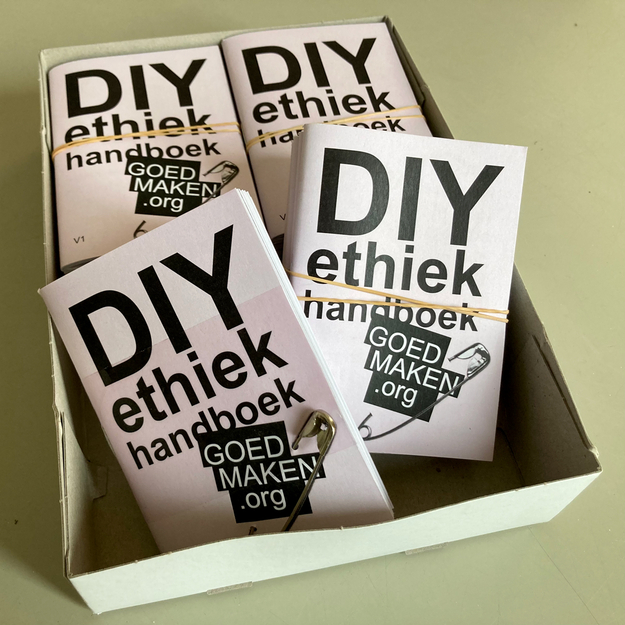
Q: Who is this book available for?
A: It’s free and for everyone! The idea is that it is a social and living project. That’s why it comes with a version number, this first one is 1.1. I hope that people give their feedback and critique, so that I can improve it in version 2, 3, 4, 5… I want the project to be very unpretentious, and include as many people as possible, especially those who maybe feel that they're not entitled to such philosophies or are not interested at first.
I hope to get them on board and to show that this learning can be on your own terms. I take inspiration from big philosophers, but also from the punk movement of the 70s. My children, and other young people, are also big inspirations in this project. It’s really important to me that the whole project works without hierarchy. That allows for a lot of playfulness. Young people especially are very sensitive to this, when there is space for them, they are happy to take it and to think and contribute to it.
Q: Do you have any advice for neurodivergent students currently navigating art and educational spaces who might be dealing with impostor syndrome, or struggling with that discomfort of figuring out their identity?
A: Yes, I think if I look at my younger self, the main thing is to acknowledge who you are. I think it's very important to be kind to yourself, which is not the same as being lazy or passive. It’s about trying and understanding what you need, and finding a place where your needs are met. I'm not saying we should be super friendly, super soft, and never have any conflicts anywhere, because neurodiverse people are not made of cotton balls, they're actually very strong. But it's very nice to understand yourself and to be aware of your needs. I wish I didn't have to be this old to finally understand it – I hope for young people today to discover it sooner than I did.
Q: My last question: Many of your projects involve designing for children, and this kind of playful education is at the center of all of it. So I wondered, continuing to engage with ethics and other social issues, how do you see playful education as a way for us to navigate the world?
A: The reason I started working for children is because there is a lot of freedom, there's a creative space, a playful attitude, and there's no doubt about the ethics involved. All the maker projects I did look as if they were for children, but they are actually for the parents to do with their children. The stuff I give them is always too difficult for a child to do on their own, so it's a trick. I got many, many parents replying to me saying, “It was so nice, I never knew I was a maker, too, and we had so much fun together. “ Concerning ethics, I love working with young students, because I really think ethics has a lot to do with intuition. If you learn to allow intuition and use the available free space, in the context of ethical discussions, it becomes playful immediately. I’m still developing this, how to be playful in the ethics bit, so hopefully I can share new insights with you during my presentation.
To learn more about Astrid's work and her approach to ethics, you are welcome to join us at our next A/artist event: Playing with Ethics and Rhythm at Mediamatic on 16th October 2023!
